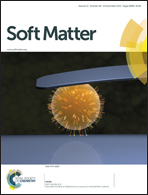Transport properties of aqueous ionic liquid microemulsions: influence of the anion type and presence of the cosurfactant†
Abstract
Transport properties, viz. specific conductivity, dynamic viscosity and apparent diffusion coefficients, were measured as a function of water content in aqueous ionic liquid microemulsions containing 1-butyl-3-methylimidazolium hexafluorophosphate, [BMIM][PF6] and bis(trifluoromethanesulphonyl)imide, [BMIM][Tf2N], stabilized by the nonionic surfactant TX-100, or its mixture with a cosurfactant, i.e. butanol. The investigation covered the whole water content range through various (Winsor I–III and dissolved solution) structures of the system. The comparative approach allowed closer inspection into phenomena being on the background of observed transport properties behavior taking into account the influence of the cosurfactant. The addition of butanol offers considerable advantages, such as an increase in conductivity, especially in systems containing ionic liquids with lower conductivity. This is accompanied by a significant decrease in viscosity, even to values that are comparable with those of molecular solvents. Moreover, the reasons for the surprisingly higher conductivity of [BMIM][PF6]-based systems were provided, and the conclusions were supported by cyclic voltammetry as well as spectrophotometric and dynamic light scattering measurements.


 Please wait while we load your content...
Please wait while we load your content...